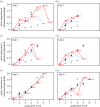Social learning in otters
- PMID: 28878997
- PMCID: PMC5579113
- DOI: 10.1098/rsos.170489
Social learning in otters
Abstract
The use of information provided by others to tackle life's challenges is widespread, but should not be employed indiscriminately if it is to be adaptive. Evidence is accumulating that animals are indeed selective and adopt 'social learning strategies'. However, studies have generally focused on fish, bird and primate species. Here we extend research on social learning strategies to a taxonomic group that has been neglected until now: otters (subfamily Lutrinae). We collected social association data on captive groups of two gregarious species: smooth-coated otters (Lutrogale perspicillata), known to hunt fish cooperatively in the wild, and Asian short-clawed otters (Aonyx cinereus), which feed individually on prey requiring extractive foraging behaviours. We then presented otter groups with a series of novel foraging tasks, and inferred social transmission of task solutions with network-based diffusion analysis. We show that smooth-coated otters can socially learn how to exploit novel food sources and may adopt a 'copy when young' strategy. We found no evidence for social learning in the Asian short-clawed otters. Otters are thus a promising model system for comparative research into social learning strategies, while conservation reintroduction programmes may benefit from facilitating the social transmission of survival skills in these vulnerable species.
Keywords: group living; network-based diffusion analysis; otters; problem-solving; social learning; social networks.
Conflict of interest statement
The authors declare no competing interests.
Figures




References
-
- Hoppitt W, Laland KN. 2013. Social learning: an introduction to mechanisms, methods and models. Princeton, NJ: Princeton University Press.
-
- Boyd R, Richerson PJ. 1988. An evolutionary model of social learning: the effects of spatial and temporal variation. In Social learning: a psychological and biological approach (eds Zentall TR, Galef BG), pp. 29–48. Hillsdale, NJ: Erlbaum.
-
- Laland KN. 2004. Social learning strategies. Learn. Behav. 32, 4–14. (doi:10.3758/BF03196002) - DOI - PubMed
-
- Rendell L, et al. 2010. Why copy others? Insights from the social learning strategies tournament. Science 328, 208–213. (doi:10.1126/science.1184719) - DOI - PMC - PubMed
-
- Hamilton WD. 1964. The genetical evolution of social behaviour. II. J. Theor. Biol. 7, 17–52. (doi:10.1016/0022-5193(64)90039-6) - DOI - PubMed
Associated data
LinkOut - more resources
Full Text Sources
Other Literature Sources
